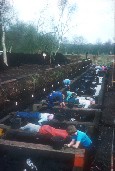Sweet Track
The Sweet Track, SomersetThe Sweet Track was discovered by a local peat cutter named Ray Sweet after whom it was named. It is one of over 40 prehistoric wooden trackways known from Somerset. It was built as a raised plank walkway through 2km of reedbed that separated the Poldens hills from the �island� of Westhay. Pairs of roundwood stakes that formed a �V� shaped cradle supported the planks. The Somerset Levels Project excavated the trackway in many places in the 1970�s. a 50m stretch is preserved in Shapwick Heath National Nature Reserve.
Tree-ring dating has shown that the oak trees used for the planks were felled in late 3807 BC or early 3806 BC. A simpler walkway of planks marked out by posts, called the Post Track, was built on the same line in 3838 BC. These are the earliest two trackways known in the UK. At this time the first farming communities were using stone axes to clear the forests dominated by massive oak trees over 400 years old.
Numerous artefacts have been found beside the trackway providing our most complete picture of the material culture of the Neolithic period. These include fine pottery, flint arrows and bows, wooden bowls, stone axes, yew pins, a wooden toy axe and a polished Jadeite axe from the Alps. Many of these seem to have been deposited in the waters of the reedswamp as offerings, possibly to the Gods of the wetlands.



